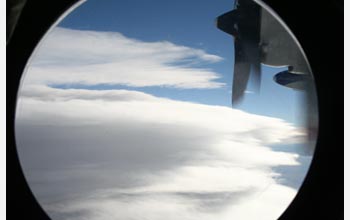All Images
News Release 09-100
Scientists Make First Direct Observations of Biological Particles in High-Altitude Clouds
Airborne dust and microbial matter appear to play large role in ice formation in clouds
This material is available primarily for archival purposes. Telephone numbers or other contact information may be out of date; please see current contact information at media contacts.

Biological particles--bacteria, pollen, fungi--act as nuclei for formation of ice in clouds.
Credit: NCAR
Download the high-resolution JPG version of the image. (4.6 MB)
Use your mouse to right-click (Mac users may need to Ctrl-click) the link above and choose the option that will save the file or target to your computer.

This NSF C-130 aircraft was used in the ICE-L project.
Credit: Kerri Pratt, UCSD
Download the high-resolution JPG version of the image. (5.4 MB)
Use your mouse to right-click (Mac users may need to Ctrl-click) the link above and choose the option that will save the file or target to your computer.

Scientist Kerri Pratt inside an NSF C-130 aircraft, with instruments for tracking cloud particles.
Credit: Kerri Pratt, UCSD
Download the high-resolution JPG version of the image. (3.9 MB)
Use your mouse to right-click (Mac users may need to Ctrl-click) the link above and choose the option that will save the file or target to your computer.


